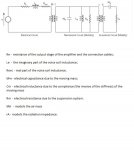Re: Damping Factor - Actual listening tests?
Thanks for the articles.
So in a day I've gone from lost, to thinking I have it all figured out, and then back to 'I guess I need to test it and listen for myself'
It looks like there are three considerations (and #2 is really just a more specific way of looking at #1):
1) power loss in the wire
2) Frequency dependent attenuation (different power loss at different frequencies due to the impedance curve of the speaker) * explained well in Dick Pierce's article
3) Distortion due to the amplifier having less ability to absorb the back EMF from the woofer * explained in the powersoft article, but still hard to predict to what extent it will manifest given a specific set of parameters
#1 is easy to calculate
#2 is relatively easy to gauge the severity of (and I think easy to mitigate with EQ)
#3 must be the elusive subjective bit that everyone is always worried about
Jason
Thanks for the articles.
So in a day I've gone from lost, to thinking I have it all figured out, and then back to 'I guess I need to test it and listen for myself'
It looks like there are three considerations (and #2 is really just a more specific way of looking at #1):
1) power loss in the wire
2) Frequency dependent attenuation (different power loss at different frequencies due to the impedance curve of the speaker) * explained well in Dick Pierce's article
3) Distortion due to the amplifier having less ability to absorb the back EMF from the woofer * explained in the powersoft article, but still hard to predict to what extent it will manifest given a specific set of parameters
#1 is easy to calculate
#2 is relatively easy to gauge the severity of (and I think easy to mitigate with EQ)
#3 must be the elusive subjective bit that everyone is always worried about
Jason


